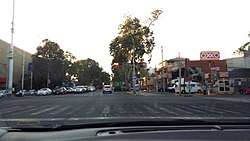Traffic-light signalling and operation
The use of traffic lights to control the movement of traffic differs regionally and internationally in certain respects. This article describes some of these non-universal features. Note that the color phase commonly known as "yellow" is often referred to, especially in official usage, as "amber"; for consistency this article uses "yellow" throughout.
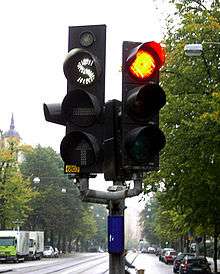
Flashing signals
In the United States and Canada, a flashing red light is the equivalent of a stop sign. In the United States, Canada, Brazil and Australia, flashing yellow does not require traffic to stop, but drivers should exercise caution since opposing traffic may enter the intersection after stopping. This may be used when there is a malfunction with the signals, or late at night when there is little traffic. A single four-way flashing light showing only one color in each direction may be used at intersections where full three-color operation is not needed, but stop or yield signs alone have not had acceptable safety performance. Yellow lights are displayed to the main road, to highlight the intersection and inform drivers of the need for caution. Red lights supplement stop signs on the side road approaches. All-way red flashing lights can supplement all-way stop control, but all-way yellow signals are prohibited by United States regulations.
In New Zealand, paired red/red traffic lights are often installed outside fire and ambulance stations on major roads, which when activated by the station, flash alternatively (so that at any time one red light is always showing), the purpose being to cause traffic to stop for a set amount of time to allow emergency vehicles to exit their station safely.
In some parts of Canada, a flashing green (known as Advanced Green) light signals permission for a left turn before the opposing traffic is allowed to enter the intersection, i.e., oncoming traffic is facing a RED light. Similarly, a flashing green may be an Extended Green, for left turns after the opposing traffic's full green phase. The flashing light may be a "full" green, or a green left arrow, both meaning the same thing. At least one traffic light in Montreal (on the Island of Montreal, 'Right-on-Red' is not allowed), has a flashing right-turn arrow, indicating that the pedestrian crossing has a red light, so it is safe to turn right and drive across it. At some intersections in Winnipeg, Manitoba, a flashing green right-turn arrow appears with a red light when traffic from the right has a green flashing left-turn arrow and is not allowed to make a U-turn. In other parts of the same country (e.g., Vancouver) a flashing green light conveys a very different meaning: the crossing road has stop signs with no lights of its own, and oncoming traffic also has a flashing green, not a red stop-light. This functions the same as a European "priority" sign (a yellow-and-white diamond shaped sign indicating that the current street is a Priority or "main" road, which cross streets must yield to at uncontrolled junctions, opposite to the usual arrangement in many European countries), for which there is no direct equivalent in North America.
The US 2009 Manual on Uniform Traffic Control Devices specifically prohibits flashing any green signal indication.[1]
Unusual traffic light phases
Turn indications
Turn prohibition
Some signals have a special phase with a red light illuminated simultaneously with a green arrow. This means that a motorist may only proceed in the direction of the arrow. In the Province of Quebec, a signal may display a green straight arrow alone, usually for 5 to 9 seconds, and then the full green (or right turn arrow) illuminates. This allows pedestrians to emerge into the roadway, and therefore (in theory) increases safety. At a few intersections green arrows appear with the red ball to allow traffic to travel in a particular direction, but the red ball is always illuminated. Examples of where this occurs include the intersection of Delaware Avenue at Harrison Street in Wilmington, Delaware, and at the intersection of West 3rd Street and Mesaba Avenue in Duluth, Minnesota. This is also true in Chicago; the straight off straight on ramps from Lake Shore Drive to N Fullerton Ave display a red light and left turn arrow or a red light, never just a green arrow.
On the island of Montréal, Québec, Canada, it is forbidden to turn right while a red signal is present. At many intersections, lights will change from red to a green arrow permitting drivers to proceed straight through the intersection. After approximately five seconds, the green arrow is replaced with a green ball signal allowing drivers to proceed forward or turn as they wish.
In the United Kingdom, there are no red or yellow "arrow" lights. Also, left or right turns on a red light are never permitted. Layouts are typically simple: either the usual three-disc all-directions signal; the same with a separate green left or right "filter" arrow which lights up either independently of the main green (permitting a turn in that direction at an otherwise red light) or along with it (showing that conflicting traffic has been stopped so turning traffic does not need to yield (known as "give way" in the UK)); or using adjacent sets where the horizontal positioning and lane layout (particularly where lanes are segregated by kerbs or islands) denotes which directions are stopped or free to move.
In the United States, some intersections have a three-lens signal without arrows with an adjoining three-lens signal (with arrows) governing exclusive left- or right-turns. Signals with circular lenses generally control all movements. At such intersections, the exclusive turn signals indicate that there are no permissive turn movements at that intersection, and that only exclusive turn movements are allowed. At those intersections, the signals with circular lenses govern movements in all directions except those in the direction which the turn signal controls. This means that if there is a left-turn signal and a circular-lens signal at an intersection, the latter signal controls right turns and straight movements, but not left turns. If the former signal is showing a red arrow, and the latter signal is showing a green ball, then motorists cannot turn left even though the latter light is showing a green ball.
Indication of protected turn
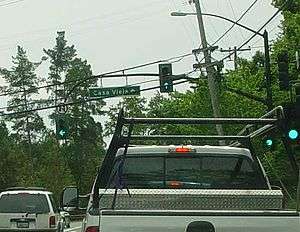
Throughout most of the United States a protected turn (a turn that can be made without conflicting traffic) is indicated by a steady burning 12-inch-diameter (300 mm) green arrow pointing in the direction of the turn. This indication may be displayed in a separate traffic signal head or may be in combination with other arrows or a green ball indication on the same signal such as with the Dallas Phasing configuration described below. Modern signal standards require that a yellow "clearance" interval be displayed for not less than three seconds prior to the protected turn interval ending.
Throughout Canada, as in the United States, a green arrow indicates protected movement in the direction of the arrow. In British Columbia, Alberta, Saskatchewan and Manitoba, green turn arrows may or may not flash; both cases indicate a protected turn phase, but a flashing green arrow indicates that the protected phase will be followed by a permissive phase.
In parts of Canada (the Maritime Provinces, Quebec, Saskatchewan and Alberta[2]), a flashing circular green light indicates right-of-way to proceed in any direction; all other entrances to the intersection will face red lights, and all pedestrian signals will indicate do-not-cross. Ontario formerly used a flashing circular green for this purpose but officially discontinued this practice on January 1, 2010.[3] The flashing-green phase usually precedes a normal green phase, in which case it is known as an advanced green, and an ADVANCED GREEN WHEN FLASHING sign will often be mounted next to the signal, possibly with a corresponding DELAYED GREEN (or similar) sign facing oncoming traffic. When a flashing-green phase occurs after a normal green phase, it as known as an extended green, but this sequence is much less common, as it can create a hazardous yellow trap for oncoming left turns.
The advanced green was originally chosen to be represented by flashing green because at the time of its introduction, in Ontario, a green arrow had meant that all traffic *must turn* in the direction of the arrow,[4] although this is no longer the case. Additionally, an advanced green could be more easily added to existing 3-lamp signals than could a green arrow, since it didn't require physically installing a fourth lamp for the arrow.
In Regina, Saskatchewan left-turn signals are designated by a two-bulb light configuration with one (or two) red balls and one LED arrow. When a left-turn cycle begins the red ball will change to a flashing green arrow to permitted all traffic turning left. When the left-turn cycle ends the flashing green arrow will turn to a solid amber arrow for five to three seconds then change back to a red ball.
Protected flashing green is now used in parts of California[5] and Ontario as part of traffic signal preemption for emergency vehicles. This does not conform to the Manual on Uniform Traffic Control Devices.
In Ireland and the UK, a right arrow may sometimes be displayed alongside a green light to indicate that oncoming traffic has been stopped and that it is safe to turn right, however this does not necessarily mean that the turn is fully protected and road users should always check that there is no oncoming or approaching traffic before turning.[6]
In Japan, a green arrow with the circular green is never shown. Instead, green arrows must be shown with the circular red. This means a signal may display green arrows pointing in all possible directions with the circular red. Another unusual sequence is that the circular red changes to circular yellow whenever some or all of the arrows end, and then changes back to red after the clearance period.[7]
Indication of permissive turn
Flashing yellow arrow
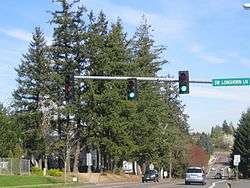
A new configuration involving a flashing yellow arrow[8] has been introduced and is gaining acceptance across the US. This configuration prevents the "yellow trap" when properly implemented. First observed in Oregon, but was started in Michigan and then spread elsewhere in the United States, like Fullerton, California;[9] Lawrence, Kansas; Tyler, Texas; Gainesville, Florida; across Georgia, North Carolina and Poughkeepsie, New York; and New York City—the signals displaying a flashing yellow arrow are being phased in to replace the five-lamp protected/permissive signals that are still in widespread use.
Four models of this signal exist. The one with lamps lamps is the most common. It has a steady red arrow, a steady yellow arrow, a flashing yellow arrow, and a steady green arrow. Another version has five lenses, with a steady red arrow, two steady yellow arrows, a flashing yellow arrow, and a steady green arrow, and is only used sometimes, when there is a leading protected left turn. There are also two with three lamps. One signal has a steady red arrow, a steady yellow arrow, and a "dual indication" third lamp which can display either a steady green arrow or a flashing yellow arrow. The other three-lamp signal has a steady red arrow, a steady yellow arrow and a flashing yellow arrow, with no green arrow; this can be used for either left or right turns, and is used to prevent yellow trap where no green arrow left turn phase exists on the approach. This cannot be done with the circular green without causing yellow trap, because a circular green releases other movements. The steady arrows all have their usual meanings. A flashing yellow arrow indicates a "permitted" left turn, where drivers may turn left without stopping (same as a Yield Sign), but opposing traffic has the right-of-way. The flashing yellow arrow must always be followed by either a steady yellow arrow or a steady green arrow.
The purpose of these signals is to allow traffic signal controllers to safely select movements as needed to maximize traffic flows, and to prevent vehicles from stacking up in left turn pockets to the point that they block through lanes of traffic. It also gives traffic engineers more flexibility with the leading and lagging protected left turn phase configurations, allowing for better progression (coordination) between signals. This saves gasoline by stopping fewer vehicles. The flashing yellow arrow is also meant to prevent yellow trap, which occurs when the circular signal turns yellow, and then red, while oncoming traffic still has a circular green. This traps left turning cars in the intersection while oncoming traffic continues to flow. It can also fool drivers into mistakenly assuming that oncoming traffic also has a yellow light, so they turn across live traffic, causing an accident. When the opposing direction has both a circular green and a protected left turn green arrow, the flashing yellow or a flashing red arrow—signifying caution or stop before turning, respectively—can be used for turns across oncoming traffic, but a steady green arrow cannot be used because the turn is not protected. The yellow trap issue was originally addressed by the configuration known as Dallas phasing; however, engineers changed the configuration for two reasons: a flashing yellow arrow was less confusing than a louvered green ball, and problems might ensue if the left turn signal comes out of adjustment and its indications are visible to through traffic.
The flashing yellow arrow was introduced not because of a perceived lack of understanding of the circular green. For turning drivers, there is no perceptible difference between the flashing yellow arrow and the circular green, because both mean the same thing; however, the meaning of the flashing yellow arrow is different for drivers who are not making the indicated turn. To the driver turning left, the flashing yellow arrow means exactly the same as a Yield Sign, and a flashing red arrow means exactly the same as a Stop sign. Left turning drivers facing a flashing yellow arrow are allowed to make a left turn if there is a gap in oncoming traffic, however when facing a flashing red arrow drivers must come to a complete stop before making a left turn. (However, the MUTCD requires that a traffic study be performed before installing a flashing red arrow signal.) With the flashing yellow arrow or flashing red arrow, opposing straight-ahead traffic has a circular green at the same time. With the steady green arrow, opposing traffic must have a circular red.
The flashing yellow arrow has an important safety advantage because it can be shown while the through signals on the same approach are red. The circular green cannot do this because the circular green controls all vehicular movements, while the flashing yellow arrow only controls movement in the direction indicated. If oncoming traffic has a lagging protected left turn (with circular green and green left turn arrow indications), the flashing yellow arrow can continue to flash to drivers turning left across the oncoming traffic, even though the straight-ahead signals are red. This indication avoids the yellow trap problem.
The flashing yellow arrow is now a standard configuration for protected/permissive turn signals in the new US 2009 Manual on Uniform Traffic Control Devices, released on December 16, 2009. Only three states are not using the flashing yellow arrows at all. In 2008, Maryland had planned to require that all new signals have flashing yellow arrows; however, their new state MUTCD prohibits the flashing yellow arrow in favor of the flashing red arrow Maryland has used for years.[10] The other states are Pennsylvania and West Virginia. Hawaii formerly did not have a flashing yellow arrow; however, its first installation was in 2014.
NCHRP Report 493[11] and the associated Web-only document 123[12] shows how most subjects understood a flashing yellow arrow better than any other permissive left turn indication, and how left turn crashes were reduced after a circular green permissive left turn signal was changed to a flashing yellow arrow left turn signal. Another advantage of the flashing yellow or red arrow face is that its operation can be changed by time of day or traffic conditions between the following modes:
- Exclusively protected (turns on green arrow, but no permissive turn)
- Protected/permissive after Yielding (turns on green arrow or flashing yellow arrow)
- Protected/permissive after Stopping (turns on green arrow or flashing red arrow)
- Exclusively permissive after Yielding (flashing yellow arrow, but no green arrow)
- Exclusively permissive after Stopping (flashing red arrow, but no green arrow)
- Prohibited (red arrow remains lit, to prevent traffic from turning across an approaching train)
The flashing yellow arrow is not allowed where left turns and other traffic share the same lane. The circular green is still allowed as a permissive left turn display, but has new restrictions:
- It may not be placed over or in front of the left turn lane in new installations.[13]
- Any yellow trap caused by a circular green must be eliminated or warned with a sign.[14]
- If one lane is shared by left turning and straight ahead traffic, the left turn movement (protected or permissive) and the straight ahead movement must begin together and must end together at the same time in the signal cycle. In this case, a green left turn arrow may not be shown with a circular red, and a red left turn arrow may not be shown with a circular green or a straight ahead green arrow.[15][16]
Dallas phasing
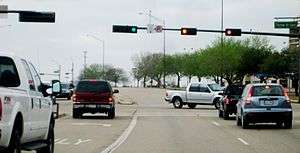
In the configuration commonly known as Dallas phasing that began in the Dallas/Fort Worth Metroplex, the five-light left turn signal head is used in a different manner than standard signals of this type. The left turn signal head operates independently from the signals for straight through traffic. This allows permissive turning even when straight through traffic is shown a red light, avoiding yellow trap. Louvers are fitted over the green and yellow balls of the left turn signal head to prevent driver confusion. The left turn signal head is also accompanied by a sign indicating its special use.[17]
In this configuration, the left-turn signal will display circular green from the leading protected left turn phase until the lagging permissive left turn phase, but the green arrow will only be displayed during the leading protected left-turn phase. During the lagging permissive left-turn phase, it is assumed that opposing traffic has both a permissive left turn phase and a straight-through green light. This can also be used in the opposite configuration, with leading permissive and lagging protected left-turn phases.[17]
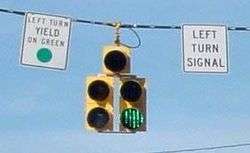
Dallas phasing gives traffic engineers more flexibility with the leading and lagging protected left turn phase configurations allowing for better coordination between signals. There are also yellow and green arrows on Dallas phasing signals, permitting exclusive protected left-turn phases as well as protected/permissive left-turn phases.
The new 2009 Manual of Uniform Traffic Control Devices prohibits this display for new installations in favor of the flashing-yellow-arrow left-turn signal, which accommodates both permissive and protected left turns. Older installations are allowed to stay until they are replaced.[18]
Flashing red ball, yellow ball, or red arrow
Michigan uses a 3-lamp traffic signal, with a red ball, yellow arrow, and green arrow; during the permissive turn, the red ball flashes. At about 372 locations a flashing red ball signal on a "protected" left turn traffic signal indicates that left turning traffic may, after a full stop, complete their turn if and only if there is a long enough break in oncoming traffic. The flashing red usually occurs when the oncoming traffic has a green signal. This function is not enabled at intersections where it may not be safe to do so (restricted view of oncoming traffic, heavy pedestrian crossings, or double-lane left turns are good examples). Michigan usually indicates signals that are dedicated to turning traffic with a sign displaying "LEFT" or "RIGHT". This sign is normally illuminated at night. More recent installations in Michigan, however, have used flashing yellow arrow signal heads, which typically have not included left-turn signal signage. All flashing red ball signals in Michigan will gradually be phased out in favor of the flashing yellow arrow.[19][20] The flashing red ball was also used in Maryland.
Delaware and Maryland have also been known to place flashing red arrows at certain intersections, especially when no signal is needed for cross traffic. The driver is required to come to a complete stop before turning. This has been published in the 2009 MUTCD as an alternative to the flashing yellow arrow. However, this was allowed only when an engineering study determined that a "stop condition" must be imposed during the permissive left turn movement.[21] Cupertino, California, also used a 4-lamp signal, with a steady red arrow, a flashing red arrow, a steady yellow arrow, and a steady green arrow; during the permissive turn, the flashing red arrow is displayed.[22] These flashing red arrows were later replaced with flashing yellow arrows.
Washington state, particularly Seattle, used a flashing yellow ball in the left-turn signal for the same purpose. Seattle also used a four-lamp signal at about 20 locations, with a red ball, a steady yellow ball, a flashing yellow ball, and a dual-mode yellow and green arrow; during the permissive turn, the flashing yellow ball was displayed.[23]
No turn arrow
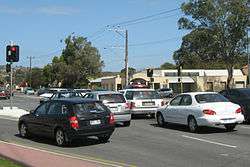
In Australia and New Zealand, an absent left or right turn arrow means traffic turning in the direction of the arrow may turn when the main light is green, provided they give way to pedestrians and other traffic.
In the state of Victoria, some intersections of this type employ a turn arrow without the red arrow. This would turn green with the main signal, before turning yellow, then off, giving priority to oncoming traffic. The nationwide standard seems to now include a red arrow that turns off. This arrow turns red simultaneously with the main light. After the cross traffic has had its turn, the arrows on opposite sides would both turn green, until one side runs out of right-turn traffic. In any case, when both sides of the intersection turn green, the corresponding arrow will turn off after a short delay, thus working similarly to the old Victorian standard. This method has the advantage of being controlled during peak-hours, where controllers would be able to prevent the arrow from turning off in extreme peak-hour traffic, but causes confusion as drivers expect a light to be on when three are present.
In New Zealand, where they drive on the left, when a road is given a green light from an all direction stop, a red arrow can continue to display to turning traffic, holding traffic back while the pedestrian crossing on the side road is given a green signal (for left turns) or while oncoming traffic goes straight ahead and there is no permissive right turn allowed (for right turns). As soon as the pedestrian signal changes to flashing red, the red arrow extinguishes. Traffic turning may now proceed provided they give way to oncoming traffic (for right turns) or pedestrians (for left turns). This method is becoming common in many states of Australia. When an intersection is given a protected turn prior to the pedestrian crossing on the side road given the green signal, the lights change to yellow and red, and then the red arrow disappears as soon as the pedestrian crossing is given a flashing red signal.
The five-light protected permissive signals in the US are the same.
Yellow arrow and ball
Around Richmond, a suburb of Vancouver, British Columbia, some left turn signals use a dual-indication LED lamp; these signals display a green arrow, a yellow arrow in addition to a yellow ball, and a red ball. A traffic signal on the intersection of the Westminster Highway and Knight Street does the same with dual-indication through and right turn arrows. All intersections with this picture are city operated.
Crosswalks
Flashing green light
In British Columbia,[24] a flashing green globe signal is used at a pedestrian crossing or intersection, at which pedestrians have the ability to stop traffic to allow a safe crossing. They may also be used at a drawbridge. The flashing green indicates that the signal is not currently in use. After the pedestrian pushes the button to trigger the signal, the light becomes a steady green until the sequence of yellow, then red (at which time the pedestrian crossing gives a walk signal) as in a conventional set of traffic lights, then returns to flashing green until another crossing is requested.[25] This indication is also used in Massachusetts at fire stations. In several European countries and Mexico, a flashing green light is used in crosswalks to indicate that signal is going to change from green to red soon. Therefore, flashing green has roughly the same meaning to pedestrians as ordinary yellow signal has for motorists. Slow-moving pedestrians are warned about oncoming signal change and have opportunity to wait for next signal cycle. Motorists are more likely to notice flashing signal. Drivers of vehicles about to cross pedestrian crossings should be more aware of incoming pedestrians.
Current users of flashing green signal are Austria, Belgium, Estonia, Finland, Great Britain, Hungary, Netherlands, Norway, Mexico, Poland, Spain and Sweden. France, Portugal and Switzerland make limited use of flashing green.
Flashing red lights
In Australia, New Zealand, some SADC countries (such as South Africa), Canada and most of the United States, a flashing red or orange pedestrian signal is used at between green and steady red; it means "complete crossing but do not start to cross". This has a similar meaning to European flashing green, but means that if a pedestrian glances at it, they will not enter an intersection without enough time to leave. In the United States and in parts of Canada, Australia and New Zealand (e.g., Auckland CBD) pedestrian signals which count down the number of seconds (see Timers below) until cross traffic has the right of way are becoming popular at heavily used pedestrian crossings such as in urban shopping districts.
Red and yellow light
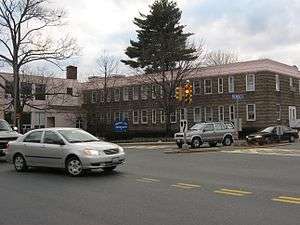
In Massachusetts only, simultaneous red and yellow lights in all directions allow a pedestrian to cross diagonally.[26] This replaces the extra "WALK"/"DON'T WALK" or white Ampelmanchen/hand signal, but is in violation of the MUTCD.[27] This practice is obsolescent but it remains in the Commonwealth's driver's manual.[26]
Other
Traffic lights for pedestrians are usually different; see pedestrian crossing. Traffic lights at level railroad crossings are again different. Both of these are to avoid confusion as to whom the signal applies.
Special signals
Transit priority signal
In Oregon, Ontario, Quebec, British Columbia, Nova Scotia, Manitoba and Alberta, traffic signals may also have an extra white rectangular light mounted above the red light. This phase indicates that a public transit vehicle may proceed through an intersection in any direction while all other traffic faces a red light.
In some areas such as Boston, Massachusetts, a trolley may have its own traffic signals, indicating that it is okay for it to cross an intersection. These signals are all white, and the top section (stop) is a horizontal bar, the middle (caution) is an upright triangle, and the bottom (go) is a vertical bar.[28]
In Australia and New Zealand, buses and trams may have a white "B" and "T" light respectively to indicate they may proceed through the intersection in any direction. A white arrow indicates that they only may proceed in the arrow's direction, common for trams to indicate that they may proceed and the points are set for proceeding that direction. Transit signals may be accompanied by red and yellow B/T signals indicating to buses and trams stop and caution respectively.[29]
Singapore uses a similar "B" light for buses, but it is green.
In many parts of Western Europe transit signals (for trams, and in some cases buses as well) employ traffic signals that are phased similarly to main traffic signals but replace the green light with a vertical white bar, the red light with a horizontal white bar and the yellow with a white dot or diamond. This is intended to avoid confusion between transit signals and main traffic signals at intersections where both sets are visible.
Emergency priority signal
At many intersections in the United States, intersections use traffic signal preemption to give priority to emergency vehicles. These preemption applications often include an illuminated "notifier" signal. A notifier is a secondary lighting device usually mounted independently of the traffic signal, such as a standard or strobing light bulb in an omni-directional enclosure or spotlights aimed at oncoming traffic lanes. The colors of these secondary lighting devices vary regionally depending upon the operational policies of the local traffic management and emergency service agencies.[30]
Reverse side red light indicator
Some jurisdictions use special small blue lights on the reverse of signal heads to indicate a red light lit on that head. They are used to communicate the presence of a red signal to police so they can view the situation without having to traverse the intersection.[31] Other jurisdictions simply drill a small hole in the red signal visor to allow police to see the status of the signal from a wide angle (but not directly opposite the signal). In France and, perhaps, Vietnam, the back of the red lights are sometimes designed with a red cross to indicate that the light is red.
Warnings that light will change
Change from green to yellow
In Austria, Cambodia, China, Estonia, Latvia, Lithuania, Russia, most of Israel, Malaysia, parts of Mexico, some places in Thailand, Turkey, and in certain other parts of Europe, the green lights will start flashing at the end of the Go or Turn phase to indicate that the yellow (Caution phase) lights are about to be engaged. This is useful in fast-paced roads to allow for longer slowing down time, and for pedestrians crossing broad streets. Some traffic lights in Pennsylvania illuminate the yellow light a few seconds before the green light turns off, to give this same warning.
Note that the 2009 Manual of Uniform Traffic Control Devices prohibits any display that gives warning of an upcoming signal change, unless that display is placed well upstream of the signal (See "Warnings of traffic light ahead" below), so traffic at the stop line can not see it.
Change from yellow to red
At some intersections in Quebec, Canada, the yellow and red lights will appear together to indicate that the light is about to change to red. This mitigates the fact that at most Quebec intersections, there is no delay between the time that the lights in one direction turn red and the lights in the perpendicular direction turn green. However, this is considered redundant in other places, as the yellow light itself indicates that the light is about to change to red.
Change from red to green
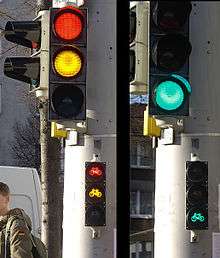
In most European countries (including Austria, Belarus, Bosnia and Herzegovina, Bulgaria, Croatia, the Czech Republic, Denmark, Estonia, Finland, Germany, Hungary, Iceland, Latvia, Lithuania, Macedonia, Malta, Moldova, Montenegro, Norway, Poland, Russia, Serbia, Slovakia, Slovenia, Sweden, Switzerland, Ukraine, and the United Kingdom), as well as in Argentina, Botswana, Colombia, some cities in China, Hong Kong, India, some places in Indonesia, Israel, some places in Japan, Liberia, Macau, Pakistan, Paraguay, and South Africa, the red and yellow lights are displayed together for one, two, or three seconds at the end of the red cycle to indicate that the light is about to change to green. This phase aids the drivers of vehicles to turn on the engines again (there are requests/advice to turn off engine in front of red traffic lights in some countries, e.g. Switzerland), or drivers with manual gearboxes, giving them time to change into first gear during the short phase, as well as drivers of vehicles that may have been yellow-trapped whilst turning right a chance to clear the intersection in more safety. It also informs drivers who may be approaching the intersection at speed that a green light is imminent, so they may proceed through the junction without having to stop (or, with enough of a lead distance, even having to slow), reducing the potential annoyance (and safety risk) of braking sharply to a halt only to have the green light appear immediately after.
Warnings of traffic light ahead
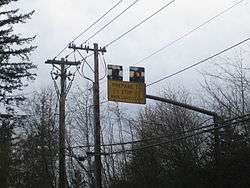
Flashing yellow lights
In some areas, a "prepare to stop" sign with two alternately flashing yellow lights is installed in locations where a high-speed road (design speed usually at least 55 mph / 90 km/h) leads up to a traffic light, where the traffic light is obscured from a distance (or both conditions), or before the first traffic signal after a long stretch of road with no signals. This is installed so that drivers can view it from a distance. This light begins blinking with enough time for the driver to see it and slow down before the intersection light turns yellow, then red. The flashing yellow light can go out immediately when the light turns green, or it may continue for several seconds after the intersection light has turned green, as it usually takes a line of cars some time to accelerate to cruising speed from a red light. These are relatively common in areas such as the United States, Canada, Western Australia, New South Wales[32], New Zealand and Liberia. Japan uses a variant signal with two lamps, a green one and a flashing yellow one, for the same purpose.
Red signal ahead
A common way of warning that an obscured traffic light ahead is red is a red-signal-ahead sign. It is shaped like a standard yellow diamond shape sign with LEDs spelling out "Signal Ahead". Just before the traffic light goes yellow, the word "Red" will light up above Signal Ahead and they will begin to flash alternately.
Strobed red lights
In some parts of the United States, a few traffic lights have slowly flashing white strobe lights superimposed on the center of the red light, which are activated when the red light itself is illuminated. These are common on highways with few traffic signals, in high-traffic, and/or high-speed areas (where drivers running red lights are a major problem), in a place where a regular traveler wouldn't expect a signal (such as a newly erected signal or one put up for construction) in other situations where extra work may be needed to draw attention to the status of the light (such as in an area where many other red lights approximate the brightness, placement and color of a red traffic signal), or the strobe may also be a flash from a camera located within the traffic signal itself (there has been much dispute as to whether this is legal or not). These are also used in areas prone to fog, as the strobing white light may be visible from a distance while the standard red light is not. A newer variant uses a flashing white LED ring located on the outer edge of the red indication as opposed to in the center of the red. Typically one strobe equipped signal is mounted as a supplement between two normal signal heads. It is worthy of note that such strobe installations have been prohibited by the FHWA since 1990; however, individual states have been slow to conform. The current MUTCD (2009 edition) contains an explicit prohibition against their use; therefore, it is still FHWA's position that strobe lights are not allowed in traffic signals and no further experimentation with these types of strobe lights in traffic signals will be approved.[33][34][35]
An example of this is located at the end of the Massachusetts I-90 Exit 6 in Chicopee, where the ramp ends at I-291.
Unusual traffic light designs
Double red lights
The Canadian provinces of Quebec, New Brunswick and Prince Edward Island generally use horizontal traffic lights with red to the left and green to the right. These signals also use specific shapes for each color, which aids color-blind people in distinguishing signal aspects:
- green – an ordinary "ball" shape,
- yellow – a diamond shape, and
- red – a square (somewhat larger than the ball shape).
In Quebec, most horizontal traffic lights have a red signal on both sides of the fixture (left and right). They are also now replacing the shaped traffic lights for color-blind people with regular round signals.
Some signals have two red lights, one on each end.
In some Texas urban areas including Houston and Dallas, the use of a double red light is different. It is typically used on left turn signals. For horizontally mounted signals, typically hung or mounted over the lanes, it is configured with two red balls or arrows, one yellow arrow or ball, and a green arrow (from left to right). For vertically mounted signals, the two red balls or arrows are on the top, then a yellow arrow or ball, and a green arrow. It is usually accompanied by signs saying "left turn signal" or "left on arrow only". Signals for traffic going straight use standard signals, usually mounted horizontally over the road. The use of two red lights on the left turn signal allows for redundancy in case one of the red lights burns out, while saving money by requiring only one signal for left turns per direction that needs one. It also prevents the yellow trap that would occur at night if a single red signal burned out, and left-turning vehicles obeyed the circular signals instead.
One type of installation in Texas uses a double red light instead of a single red light to make the red light more pronounced and visible from a distance. In this installation, it is the first traffic light on a rural highway for miles, and traffic approaches at highway speed (65 mph). The double red light makes the red phase of the light visible at a greater distance than the yellow and green on the same signal. This installation is also used on rural highways in California, always in a vertical configuration, and in either configuration in some cities of Mexico such as Guadalajara.
The double-red light also makes an appearance in North Carolina in left-hand turn lanes. It serves the same purpose as the vertical Texan configuration, and mainly appears on boulevards with multiple lanes of traffic where a left turn may become catastrophic due to visibility. Double red arrows are used for left turn installations on some county-managed roads in Henrico County, Virginia and Baltimore County, Maryland.
The double-red ball aspect is used in Saskatchewan and Alberta, Canada, to indicate a protected-prohibited left turn signal. A sign with the universal no left turn symbol and a depiction of the double red light is mounted near the signal to indicate that no left turns are permitted on a double-red light. Intersections with this configuration are quite common in Saskatoon, Calgary, and Edmonton. According to Transportation Alberta, there is no legal significance to a double red light. [36]
In some cities in Mexico, the double red light is treated as a standard red signal, with the double light's purpose being to increase the signal's visibility as well as providing a redundant light in case one of failure of one of them.
Clock-type traffic lights
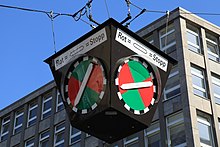
These so-called "Heuer-Ampeln", developed by the German Heuer-Hammer company were used in the Netherlands, Austria (Vienna) and Germany from the 1930s until the 1960s, with the last of them being replaced with the by then common known traffic lights in 1972.
Traffic lights in Tianjin, China
Tianjin in the People's Republic of China has two very special systems of traffic lights, in use since c. 2000:
"Bar" lights
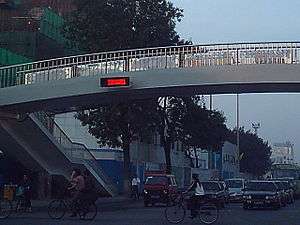
One system is where there is a horizontal bar in a specific colour, with the colour changing and the bar shrinking. The shrinking bar indicates the time remaining in that colour. The colour itself is either red (stop), yellow or green (go). A blinking green one-third-full bar means "reduce speed now", and a blinking yellow full-bar indicates "proceed with caution".
When lights of this system turn from green to red, the diminishing green bar will flash once two-thirds (note: not the full bar) of the green bar is "eaten up", with the remaining third intact. A full, uninterrupted yellow bar will appear for a few seconds before, after a short blink, lights turn red. Immediately after the full red bar appears, a tiny (almost unnoticeable) split/division appears to signify the bit that will not be "eaten up". This corresponds to the usual position of a red light (leftmost, or rightmost if at the other end of the road and at the other side of the pavement; or the upper third). When two-thirds of the red bit is "eaten up", the red light extinguishes, only to be replaced nearly immediately with a full chunk of green (again with the minute division). The process then repeats itself.
Arrow lights

Another system, which is also common in the other cities in China, is where there is a set of three lights as traffic lights. Every light is an arrow pointing in a different direction and every arrow has a colour of its own, to show whether traffic flow is permitted or prohibited in that direction.
The major disadvantage of this system of traffic light is that it is unfamiliar to those who are used to seeing specific colours of the traffic lights at the various ends of a normal traffic light itself (e.g. green rightmost, red leftmost, etc.) as well is being problematic for the color blind (although by Chinese traffic laws, people who are color blind are not permitted to drive). It does, however, conserve space. The other disadvantage of it is it does not have indication of when a turn can be made without yielding and when the turn can made only after yielding to the oncoming traffic. Although by Chinese traffic laws, turning is always supposed to be made after yielding to oncoming traffic.
Elsewhere in China, a blinking green light means "reduce speed now", attempting to stop cars from passing (if that car can still safely stop in time) and is nearly universal in appearance. Some cities or parts of cities show the number of seconds remaining in a specific traffic light colour (a so-called "countdown meter").
Another type of signal that can be found in China is the Unilight signal that displays all three colours in one signal section.
Unusual uses of traffic lights
Ramp metering
A ramp meter or metering light is a device, usually a basic traffic light or a two-phase (red and green, no yellow) light, that regulates the flow of traffic entering freeways according to current traffic conditions. They are intended to reduce congestion on the freeway in two ways. One is to ensure that the total flow entering the freeway does not exceed the capacity at a downstream bottleneck. A second is to break up platoons of vehicles entering freeways, ensuring that traffic can merge more easily. Some metered ramps have bypass lanes for high-occupancy vehicles, allowing car-poolers and buses to skip the queue and get directly on the highway. Meters often only operate in rush hour periods.
On some large toll bridges, such as the San Francisco–Oakland Bay Bridge, red/green traffic lights, similar to ramp meters, are used to stagger traffic leading into the bridge. In the Bay Bridge's case, approximately 25 lanes of toll booth traffic are reduced to five lanes of bridge traffic in about 1/2 mile. To accomplish this, an overhead red/green traffic light is visible above each lane, several hundred feet beyond the toll plaza. Green is illuminated for two seconds, signalling the first driver in that lane to begin acceleration. Then the signal jumps to red for eight seconds. Using this method, there are always five lanes with a "green" signal, staggered throughout the 25 lanes of traffic.
Timers
Traffic lights are sometimes accompanied by timers that indicate how much longer a certain phase will last. This is especially common for pedestrian crossing lights in high-traffic areas. Timers have been extensively used in India, Indonesia, China, Thailand, Philippines, Cambodia and Vietnam for both pedestrian and vehicular traffic but in Vietnam, they are rarely used for pedestrians.
In Canada and the United States, most pedestrian signals now have countdown timers in the flashing hand symbol/"Don't Walk" phase. All new installations of pedestrian signals in the United States must include a countdown timer, unless the countdown timer is less than seven seconds long, per the 2009 MUTCD. In New York City, however, this is not the case, as only streets that are wide enough will get countdown timers, regardless of the length of the countdown.[37] Countdown pedestrian signals are also used in London, United Kingdom.[38]
In some cities (such as Newberg, Oregon; Kiev, Ukraine; and Kraków, Poland) there are signs displaying how fast one has to drive in order to reach the next intersection at the exact time when the light turns green, thus allowing the driver to ease into a green wave.
Other
Other places where there may be traffic lights (normal or special ones):
- flashing signals used in conjunction with warning signs (such as dangerous curves, speed limit reductions, school zones, signal ahead, low clearance, flooding, icing, or fog) and regulatory controls (such as Stop and Yield signs).
- on waterways with signs to implement special reduced speed "no wake" zones for watercraft.
- at public boat ramps to warn drivers before accidentally driving into the water.
- at the landing-stage of a ferry and aboard the ferry.
- at the entrance and exit of a parking place or garage.
- at the entrance and exit of some car washes, to indicate when the engine should be in gear and whether the brakes may be operated at a given time.
- at drive through lanes such as those at banks.
- at an international Port of Entry inspection station.
- at highway inspection and/or weigh stations.
- before a drawbridge.
- before a narrowing of the road.
- at a fire station or medical emergency entrance.
- at a tunnel entrance.
- in some HOV lanes.
- to allow cattle to cross – as on the A470 in Wales or A65 in North Yorkshire, England.
- at road construction sites to regulate temporary two-way traffic over a single open lane.
- at airports to regulate aircraft taxiways.
- adjacent to some airports where vehicular traffic on highways (crossing just past the end of a runway) must stop or yield during aircraft takeoffs and landings.
- at the entrance to water slides where they are used as a safety feature to prevent people going down slides too soon after each other.
- on automobile racing circuits to advise race drivers whether they can race or must slow or stop
- at the end of a dead-end road to warn that the road ends, usually installed in locations where many accidents have occurred.
- reversible 'one way' signs to indicate to occupiers of a traffic light controlled, narrow road which direction the traffic is currently expected in, such as the 2 in High Street Paulton, England
References
- MUTCD 2009 Edition: Chapter 4D, item D of paragraph 3 states specifically, "A flashing green signal indication has no meaning and shall not be used."
- Government of Alberta Archived October 7, 2011, at the Wayback Machine, Chapter 2, page 49
- Ministry of Transportation of Ontario (March 2012). "3.8 Flashing Operation". Ontario Traffic Manual Book 12: Traffic Signals. p. 55.
- McCaffrey, Gordon (September 1964). "Electronic Genie Speeds Traffic Through 1001 Lights". Popular Science.
- Groh-Gordy, Michelle (2006-10-01). "Red, stop. Green, go. Flashing red, stop. But flashing green?". Inland Valley Daily Bulletin. Archived from the original on 2007-03-09. Retrieved 2008-04-16.
- "Traffic light signals - Light signals controlling traffic - The Highway Code - Guidance - GOV.UK". www.gov.uk. Retrieved 2019-06-03.
- "www.npa.go.jp/annai/license_renewal/english.pdf" (PDF). Archived from the original (PDF) on 2013-07-22. Retrieved 2013-09-17.
- "Fixing the Yellow Trap". Projects.kittelson.com. Retrieved 2010-10-18.
- "Top News". Synchronex-usa.com. Archived from the original on 2011-07-16. Retrieved 2010-10-18.
- "Maryland Manual on Uniform Traffic Control Devices - 2011 Edition". Maryland State Highway Administration. Retrieved 3 April 2012.
- "NCHRP Report 493" (PDF). Transportation Research Board. Retrieved 2011-06-28.
- "Web Only Document 123" (PDF). Transportation Research Board. Retrieved 2011-06-14.
- "MUTCD Section 4D.13".
- "MUTCD Section 4D.05".
- "MUTCD Section 4D.17".
- "MUTCD Section 4D.19".
- Dallas Phasing With Doghouse Configuration - Lead Left-turn; Dallas Phasing With Doghouse Configuration - Lag Left-turn
- MUTCD 2009 Edition, Chapter 4D, sections 4D.18 and 4D.20 prohibit the use of circular green in a separate left-turn signal face. However, existing installations can remain for the remainder of their useful life.
- "Flashing Yellow Arrow Left-Turn Signal". Michigan Department of Transportation. Retrieved 2008-01-03.
- Michigan Flashing Red Ball
- MUTCD 2009 Edition, Chapter 4D Sections 4D.18 and 4D.20
- Flashing Red Arrow Used in Cupertino, CA
- Seattle Flashing Yellow Ball
- ICBC Archived October 22, 2013, at the Wayback Machine, Chapter 3, page 9
- "BC Ministry of Transportation and Infrastructure FAQ". Th.gov.bc.ca. Retrieved 2013-09-17.
- Massachusetts Department of Transportation, Registry of Motor Vehicles Division (c. 2015). Driver's Manual (PDF). p. 82.
You must yield to pedestrians if your traffic signal is red or if it is red and yellow.
- "MUTCD 2009 Edition, Chapter 4D". Mutcd.fhwa.dot.gov. Retrieved 2013-09-17.
- Manual on Uniform Traffic Control Devices, Section 10D.07
- "Giving way at controlled intersections - New Zealand Road Code". New Zealand Transport Agency. Archived from the original on 9 June 2011. Retrieved 13 June 2011.
- Usenet Message-ID 3E1475C9.738C8F95@alum.wpi.edu (January 2, 2003)
- Griggs, Gregory W (2006-09-06). "Simi Valley Adds Blue Traffic Lights". Los Angeles Times (Ventura County edition). Retrieved 2008-04-16.
- "Google Maps". Google Maps. Retrieved 2017-08-01.
- This position was formalized on July 2, 2003 with an Official Interpretation of the MUTCD, number 4-263(I), "Strobes Florida DOT".
- Manual on Uniform Traffic Control Devices, Frequently Asked Questions - Part 4 Highway Traffic Signals, Question 21
- MUTCD 2009 Edition, Chapter 4D Section 4D.06, Paragraph 3 contains a new prohibition against strobes in traffic control signal
- "Driver's guide to operation, safety and licensing : Cars and light trucks - Open Government".
- "Pedestrian Countdown Signal Locations" (PDF). Retrieved 2013-09-17.
- Lydall, Ross (21 June 2010). "You have six seconds to cross: digital countdown installed for pedestrians". London Evening Standard. Archived from the original on 24 July 2010. Retrieved 24 July 2011.
External links
- Left-turn Signal Display Animation Page adapted from Evaluation of Traffic Signal Displays for Protected/Permitted Left-Turn Control (Report 493, 2003) by the National Cooperative Highway Research Program
